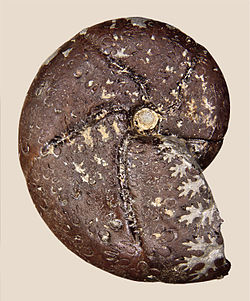User:Abyssal/Portal:Jurassic
Introduction
The Jurassic (/dʒʊˈræsɪk/ juurr-ASS-ik) is a geologic period and stratigraphic system that spanned from the end of the Triassic Period 201.4 million years ago (Mya) to the beginning of the Cretaceous Period, approximately 145 Mya. The Jurassic constitutes the middle period of the Mesozoic Era and is named after the Jura Mountains, where limestone strata from the period were first identified.
The start of the Jurassic was marked by the major Triassic–Jurassic extinction event, associated with the eruption of the Central Atlantic Magmatic Province (CAMP). The beginning of the Toarcian Stage started around 183 million years ago and is marked by the Toarcian Oceanic Anoxic Event, a global episode of oceanic anoxia, ocean acidification, and elevated global temperatures associated with extinctions, likely caused by the eruption of the Karoo-Ferrar large igneous provinces. The end of the Jurassic, however, has no clear, definitive boundary with the Cretaceous and is the only boundary between geological periods to remain formally undefined. By the beginning of the Jurassic, the supercontinent Pangaea had begun rifting into two landmasses: Laurasia to the north and Gondwana to the south. The climate of the Jurassic was warmer than the present, and there were no ice caps. Forests grew close to the poles, with large arid expanses in the lower latitudes. (Full article...) (Full article...) Selected article on the Jurassic world and its legacies
The evolutionary history of life on Earth traces the processes by which living and fossil organisms have evolved since life on the planet first originated until the present day. Earth formed about 4.5 Ga (billion years ago) and life appeared on its surface within one billion years. Microbial mats of coexisting bacteria and archaea were the dominant form of life in the early Archean. The evolution of oxygenic photosynthesis, around 3.5 Ga, eventually led to the oxygenation of the atmosphere, beginning around 2.4 Ga. The earliest evidence of eukaryotes (complex cells with organelles), dates from 1.85 Ga, and while they may have been present earlier, their diversification accelerated when they started using oxygen in their metabolism. Later, around 1.7 Ga, multicellular organisms began to appear, with differentiated cells performing specialised functions.
The earliest land plants date back to around 450 Ma (million years ago), although evidence suggests that algal scum formed on the land as early as 1.2 Ga. Land plants were so successful that they are thought to have contributed to the late Devonian extinction event. Invertebrate animals appear during the Vendian period, while vertebrates originated about525 Ma during the Cambrian explosion. During the Permian period, synapsids, including the ancestors of mammals, dominated the land, but the Permian–Triassic extinction event251 Ma came close to wiping out all complex life. (see more...) Selected article on the Jurassic in human science, culture and economics
Mary Anning (1799 – 1847) was a British fossil collector, dealer, and palaeontologist who became known around the world for important finds she made in Jurassic marine fossil beds in the cliffs along the English Channel at Lyme Regis in the county of Dorset in Southwest England. Her work contributed to fundamental changes in scientific thinking about prehistoric life and the history of the Earth.
Mary Anning searched for fossils in the area's Blue Lias cliffs. Her discoveries included the first ichthyosaur skeleton correctly identified; the first two plesiosaur skeletons found; the first pterosaur skeleton located outside Germany; and important fish fossils. Her observations played a key role in the discovery that coprolites, known as bezoar stones at the time, were fossilised faeces. She also discovered that belemnite fossils contained fossilised ink sacs like those of modern cephalopods. Anning did not fully participate in the scientific community of 19th-century Britain, who were mostly Anglican gentlemen. She struggled financially for much of her life. Her family was poor, and her father, a cabinetmaker, died when she was eleven. She became well known in geological circles in Britain, Europe, and America. Nonetheless, as a woman, she was not eligible to join the Geological Society of London and she did not always receive full credit for her scientific contributions. After her death in 1847, her unusual life story attracted increasing interest. (see more...) Selected image
Did you know?
Need help?Do you have a question about Abyssal/Portal:Jurassic that you can't find the answer to? Consider asking it at the Wikipedia reference desk. GeochronologyEpochs - Early Jurassic - Middle Jurassic - Late Jurassic Landmasses - Baltica - Gondwana - Laurentia - Siberia Fossil sites - Beecher's Trilobite Bed - Walcott–Rust quarry Researchers - Charles Emerson Beecher - Charles Lapworth - Charles Doolittle Walcott Quality ContentFeatured Mesozoic articles - Bone Sharps, Cowboys, and Thunder Lizards - Bone Wars - Edward Drinker Cope - Geology of the Capitol Reef area - Geology of the Death Valley area -Geology of the Grand Canyon area - Geology of the Zion and Kolob canyons area Good Mesozoic articles - Chitinozoan - Coal ball - Dimetrodon - History of paleontology - Evolutionary history of life - Ornatifilum - Opabinia - Paleontology- Schinderhannes - Small shelly fauna - Temnospondyli - Tiktaalik - Waptia SubcategoriesRelated contentAssociated WikimediaThe following Wikimedia Foundation sister projects provide more on this subject:
|





















